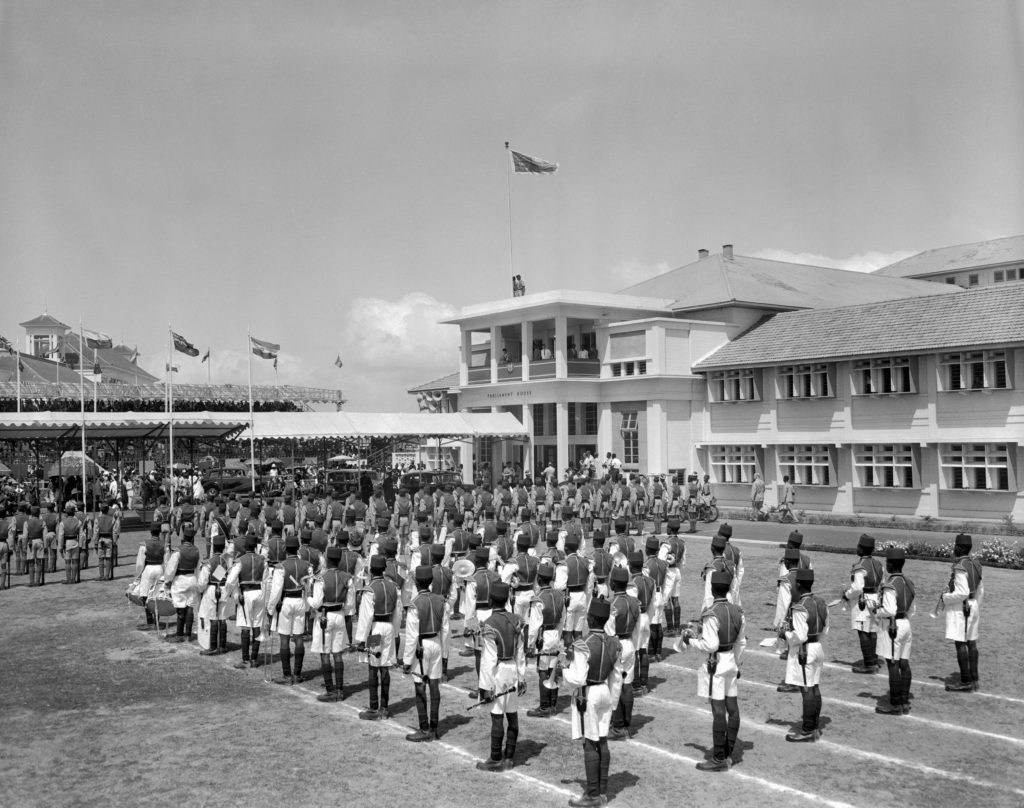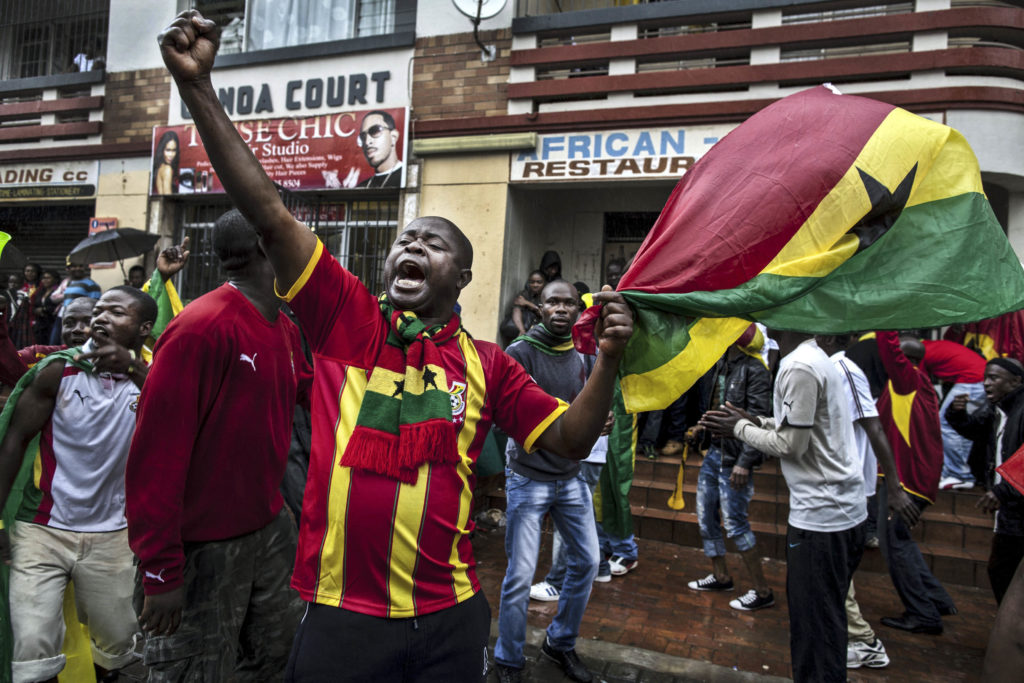Kwame Nkrumah, Ghana’s first president and liberation leader, is often given credit for the design. But it was, in fact, a 35-year-old artist and sportswoman named Theodosiah Okoh who came up with it, after answering a national call for new flag ideas.
A casual glance at the flags of Africa, makes it seem as if dozens of her countries hired a single, lazy designer who, instead of coming up with a bespoke flag for each nation, simply arranged the same few colours in slightly different shapes and configurations.
Guinea: vertical stripes in red, gold and green. Mali: vertical stripes in green, gold and red. Senegal: identical to Mali, just with a green star in the middle. Ghana: like Senegal, but the star is black and the stripes are horizontal. Guinea-Bissau and Benin: almost identical blocks of red, gold and green, except the colours are in a different order and Guinea-Bissau sports a black star like Ghana.
And on it goes. The red, gold and green motif repeats itself on the national flag of at least 23 African countries. But this is no coincidence — nor a lazy designer.
Instead, the flags represent an intentional show of support and solidarity from when, in the 1960s, dizzying waves of nationalism swept across the continent and countries yanked their freedom from colonial Europe.
The colours of an African empire
Red. Yellow. Green. The colours — both a reminder for countries whose independence was slow to come that they were not alone, and a warning to the colonisers that their oppressive systems would be conquered in their entirety — were borrowed from Ethiopia’s 123-year-old banner.
 The Ethiopian Negus Haile Selassie I taking part in an official ceremony. Addis Ababa, 1966. (Photo by Mondadori via Getty Images)
The Ethiopian Negus Haile Selassie I taking part in an official ceremony. Addis Ababa, 1966. (Photo by Mondadori via Getty Images)
Imperial Ethiopia, whose armies made short work of encroaching Italian troops, was one of only two African nations, along with Liberia, never colonised (save for a short Italian occupation). Nationalist leaders saw the country as a beacon of hope. The Ethiopian court’s tricolour flag was originally inspired by the rainbow, according to historian Whitney Smith, and dates back to pennants (tapered flags used for identification or signalling) flown in the 17th century at the time of the Aussa Sultanate — a kingdom that existed in eastern Ethiopia.
Historians are not sure exactly what the colours mean, but some say they represent Christianity’s Holy Trinity — a nod to the line of emperors claiming to be descendants of Solomon, the last of which was Emperor Haile Selassie. The same colours would be appropriated by Rastafarianism, the religion which accords divine status to Emperor Selassie.
Ghana was the first country to pick up on Ethiopia’s colour scheme. Kwame Nkrumah, the country’s first president and liberation leader, is often given credit for the design. But it was, in fact, a 35-year-old artist and sportswoman named Theodosiah Okoh who came up with it, after answering a national call for new flag ideas.
 The royal standard is lowered, and the flag of Ghana raised, as the Duchess of Kent leaves the assembly building after reading the Queen’s speech to Parliament, making Ghana independent. As from midnight, Ghana, formerly the Gold Coast, became fully independent within the Commonwealth.
The royal standard is lowered, and the flag of Ghana raised, as the Duchess of Kent leaves the assembly building after reading the Queen’s speech to Parliament, making Ghana independent. As from midnight, Ghana, formerly the Gold Coast, became fully independent within the Commonwealth.
Ghana’s new leadership wanted something symbolically appropriate to replace the flag of the Gold Coast colony — a blue ensign featuring an elephant, a palm tree and a too-red sunset below Britain’s Union Jack. Harcourt Fuller, a history professor at Georgia State University notes that “the position of the Gold Coast below the Union Jack may have reflected its lower status as a colony of superior imperial power”.
Okoh’s design represented a comprehensive rejection of the old flag. Red was for the blood spilt in the struggle for independence. Yellow for the vast reserves of gold and minerals in Ghana — and reminiscent of the lustrous banners of the ancient Ashanti Empire, that featured a golden stool set in black. Green for the land; for the bounties of its harvest. On the yellow middle stripe, where Ethiopia’s Lion of Judah symbol then sat — replaced by a blue disk and gold star on Ethiopia’s modern flag — Okoh placed a black star.
“I added the black star for the colour of the black people,” Okoh said in a 2013 interview.
Erased from history
As African colonies liberated themselves, one after the other, they were inspired by independent Ghana’s new flag. First Guinea, then Cameroon, Senegal, Togo and the former Republic of Rwanda took the colours. Mali, the Republic of Congo and the Republic of Dahomey (now Benin) followed. The colours became synonymous with the wave of pan-Africanism that was sweeping the continent — a connection so powerful that the colours are even featured on more recent flags, such as that of post-apartheid South Africa.
This symbolism has its roots in Okoh’s design. Unfortunately, there is little documentation of her flag design process. It is perhaps why her contributions appear to have been underplayed and subtly erased over the years.
Also, Ghana’s flag has another popular origin story.
In the 1930s, when Nkrumah was studying in the United States, he met and was greatly influenced by Marcus Garvey — one of the intellectual architects of pan-African thought. Garvey believed strongly that African-Americans should be “free citizens of Africa, the Motherland of all Negroes”. The influences of men such as Garvey fuelled Nkrumah’s struggle against imperial forces and his vision for a united African government.
Garvey convened the Universal Negro Improvement Association in 1914 and took for its banners the colours red, black and green — another modification of Ethiopia’s flag. In 1919, he founded the Black Star Line, a shipping venture that would transport African-Americans to Africa and fulfil his dream of a connected black nation. The Black Star Line’s emblem was a red banner with a five-pointed black star at its centre.
“The flag of Ghana was announced to the world on 10 October 1956, and was, as we all know it today, resplendent in its Ethiopian colours emblazoned in the Black Star which Nkrumah had borrowed from Garvey,” wrote William Crampton, a prominent British vexillologist.
But Nkrumah could not have borrowed the black star, because Nkrumah did not design the flag. The detail in Okoh’s design may have prompted Nkrumah’s approval, but that’s about it.
Flag designers are often left unrecognised. Nigeria’s flag designer Taiwo Akinkunmi was compensated at independence but lived in poverty for years until Sunday Olawale Olaniran, a researcher, found him and brought his plight to the limelight. Okoh was never even informed that her design had been selected — she found out when she saw images of her flag being hoisted during Ghana’s independence day ceremonies. There were no approval letters, no official emissaries, no attribution, nothing.
An enduring symbol
Okoh’s iconic design remains Ghana’s symbol today. There have been two interruptions: a brief period in 1958 when Guinea and Mali temporarily merged with Ghana to form the Union of African States; and in 1964 when Nkrumah, in his authoritarian phase, replaced the yellow stripe in the middle of the flag with a white stripe, to better match the ruling party colours.
 (Photo by Jonathan Torgovnik/Getty Images)
(Photo by Jonathan Torgovnik/Getty Images)
Okoh died in 2015. On her death, her government acknowledged her contribution: “The instant recognition that our nation receives the world over through the unique flag that she designed for us has cemented her place in history as a colossus of Ghanaian history,” said the minister of communications. At her funeral, Okoh’s coffin was wrapped in the very emblem she created 58 years before.
“She was a huge inspiration to me as an artist,” writes Ian Jones-Quartey, a Cartoon Network producer and Okoh’s grandson. “Her presence in our family made the path of art viable and even honourable. I don’t think I could be doing the work I do now without her.” Jones-Quartey, producer of the popular animated series Steven Universe, based the character of Nanefua Pizza — the sweater-loving, dog-fearing, matriarch of a Ghanaian family business — on his grandmother.
Even in death, Okoh’s Black Star lives on. It is reborn every time the Black Stars — the national football team — take to the pitch; and every time Ghana’s national anthem is sung. The third stanza reads:
Raise high the flag of Ghana
And one with Africa advance
Black Star of hope and honour
To all who thirst for liberty
Where the banner of Ghana freely flies
May the way to freedom truly lie.
These words may have been written for Ghana, but they apply equally to the other 20-plus African countries whose flags are inspired by Okoh’s design. Red, green and gold is not just a pretty colour scheme. It is solidarity.
This article was first published in The Continent, the new pan-African weekly newspaper designed to be read and shared on WhatsApp. Download your free copy here.
Correction: A photograph originally published with this article purporting to show Theodosia Okoh in fact showed her sister, Dr Letitia Eva Obeng. We apologise for this error. Thank you to Jonas Nyabor from Dubawa for bringing it to our attention.